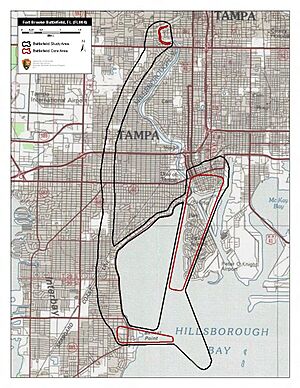Battle of Fort Brooke facts for kids
Quick facts for kids Battle of Fort Brooke |
|||||||
|---|---|---|---|---|---|---|---|
| Part of the American Civil War | |||||||
|
|||||||
| Belligerents | |||||||
| Commanders and leaders | |||||||
| Units involved | |||||||
| USS Tahoma USS Adela |
2nd Florida Infantry, Company A | ||||||
| Casualties and losses | |||||||
| 16 | Unknown | ||||||
The Battle of Fort Brooke was a small fight during the American Civil War. It happened from October 16 to 18, 1863, in and around Tampa, Florida. The main goal of this battle was to destroy two Confederate ships. These ships were called blockade runners and were hidden on the Hillsborough River.
Contents
Why the Battle Happened: The Blockade
During the American Civil War, the Union had a big plan called the Anaconda Plan. This plan was to set up a blockade along the coast of the Confederate States. A blockade means blocking ports so ships cannot go in or out.
Tampa's Role in the War
Even though Tampa was a small town back then, it was an important port. Before the war, farmers and ranchers in Florida used Tampa to send out cattle and crops. By 1862, most ships from Tampa couldn't get through. This was because Union Navy ships were patrolling near Tampa Bay.
Blockade Runners: Sneaking Through
However, some fast ships called blockade runners were based in Tampa. These ships were good at sneaking past the Union blockade. They would carry cattle and cotton to Spanish Cuba. In return, they would bring back important goods and gold for the Confederacy.
The First Battle of Tampa
In June 1862, a Union gunboat called USS Sagamore sailed into Tampa Bay. It demanded that the small Confederate army at Fort Brooke surrender. The Confederates refused, so the gunboat fired at the town. The fort fired back. No one was hurt, and no damage was done. The Sagamore left after about a day. This short fight didn't stop the blockade runners. But it did help the Union learn how far the Confederate cannons could shoot.
The Battle of Fort Brooke: The Attack
In the fall of 1862, Captain A.A. Semmes led the Union naval forces off Florida's west coast. He decided it was time to stop the blockade running from Tampa.
Union Ships Arrive
On October 16, 1863, two Union gunships, USS Tahoma and USS Adela, entered Tampa Bay. They started to slowly fire at Fort Brooke. They stayed far enough away so the fort's cannons couldn't hit them.
The Secret Landing Party
Two days later, on October 18, a Union raiding party landed secretly. This group was led by Acting Master T.R. Harris. They landed at Ballast Point. Today, this is near where Bayshore Boulevard and Gandy Boulevard meet.
March to the Shipyard
While the Union gunships kept firing at the fort to distract the Confederates, about 100 Union soldiers marched. They walked about 14 miles north through thick woods. This area is now neighborhoods like Palma Ceia and Seminole Heights. Their target was the Jean Street Shipyard on the Hillsborough River. This is near where Sligh Avenue is today.
Destroying the Blockade Runners
When the Union troops reached the shipyard, they quickly took control. They burned several ships docked there. This included two famous blockade runners: the steamship Scottish Chief and the sloop Kate Dale.
Confederate Chase and Battle of Ballast Point
The owner of the ships and shipyard was James McKay, who was once mayor of Tampa. He escaped capture and quickly warned the Confederate forces at Fort Brooke. The 2nd Florida Infantry Battalion, along with a cavalry unit called the Oklawaha Rangers, quickly chased the Union soldiers. They caught up near where the Union troops had landed at Tampa Bay.
A short but fierce fight happened there. This was known as the Battle of Ballast Point. The Union troops were trying to get into their small boats, called dinghies, to return to their ships. The Union ships Tahoma and Adelia fired at the Confederate forces on shore. This gave cover to the raiding party. The Union soldiers reached their ships, but 16 of them were hurt. Soon after, the Union forces sailed out of Tampa Bay.
What Happened Next
The blockade runner Scottish Chief was badly damaged but did not sink after it burned. It was pulled downriver to near where Blake High School is now. It was stripped of useful parts and then destroyed. The steamer A.B. Noyes was also damaged in the raid. It was taken apart to prevent the Union from capturing it. The Kate Dale sank near where it was docked. It is still at the bottom of the Hillsborough River near ZooTampa.
Impact of the Raid
The raid achieved its goals. Shipping from Tampa almost completely stopped for the rest of the war. This hurt the Confederate war effort and damaged the local economy. When Union forces landed in Tampa again in May 1864, Fort Brooke was empty. The town had been mostly abandoned. The remaining cannons and supplies at the fort were destroyed. After a short time, the Union troops left the area.
Images for kids



